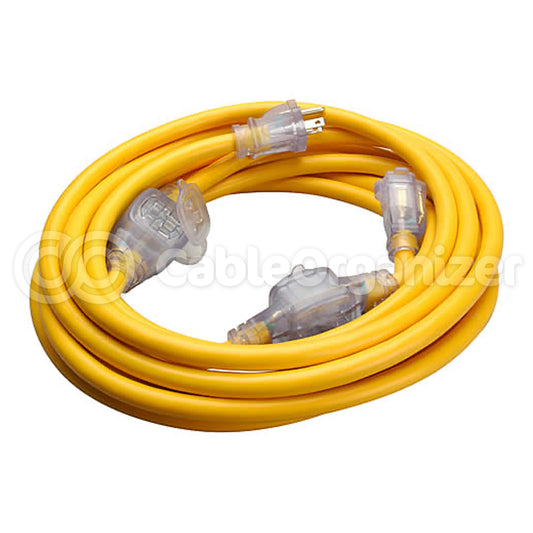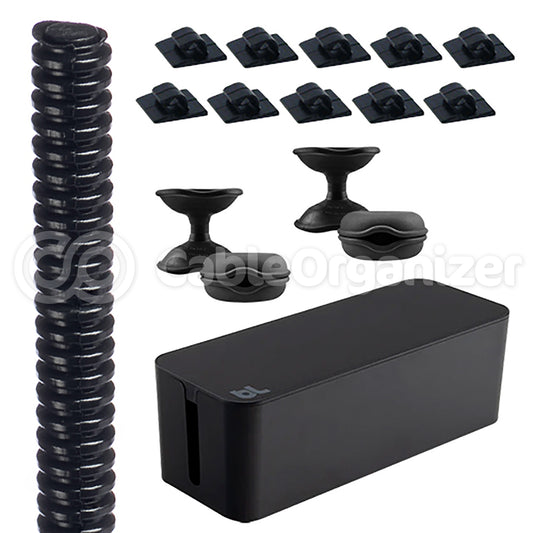Extension Cord Safety Tips
By: CableOrganizer®
If you're like most folks, your extension cord needs — as far as you know — are as follows: it must be big (like, longer than a normal cord) and orange or green (because extension cords are typically these colors). However, it's worth knowing that there's more to extension cords than length and orange or greenness. Just because a particular cord is long enough, it's not necessarily the right one for the job.
Power extension cords are not all created equal. In fact, they're not even all orange or green. Some come in colors that match your interior décor too. They're manufactured to be used in different environments and to carry varying amounts of electrical current. By basing your choice of extension cord on each task’s specific requirements, you can greatly reduce the risks of fire, electrical shock and serious injury. Nobody wants their epitaph to read, “Here lies ____. He/she is here after using the wrong extension cord.” Keep reading below where you'll find a brief extension cord tutorial and helpful safety tips, courtesy of CableOrganizer®.
INDOOR & OUTDOOR CLASSIFICATIONS

Extension cords are classified for either indoor or outdoor use. What's the difference between the two, besides the obviousness of where they're meant to be used? The insulation — or jacket — of an outdoor-rated extension cord is made of a tougher material that is designed to withstand temperature changes, moisture, UV rays and sometimes chemicals. While it's fine to use an outdoor power cord indoors, never use an indoor-rated extension cord for an outside job, because doing so could cause electric shock or create a fire hazard.
GAUGE, DISTANCE & WATTAGE RATING
Any electrical cord — extension or otherwise — contains an inner metal conducting wire, which carries electrical current from one end to the other. The thickness of this conductor is referred to as its gauge. Gauge is indicated by a number: the lower the number, the thicker the wire, based on the American Wire Gauge (AWG) system. A wire's thickness directly affects the amount of current (or wattage) it can carry over a certain distance.
The number of watts an extension cord can safely transmit (given its length and gauge) is known as a wattage rating. Before plugging an appliance or power tool into an extension cord, it is extremely important to be sure that the power demand (or pull) of that device doesn't exceed the cord's wattage rating. On the same note, if you'll be powering multiple devices from one extension cord, calculate the combined energy requirements of the devices and make sure that the total isn't higher than the wattage rating for that cord. Never use an extension cord to supply more wattage than it's rated for, since overheating and fire may occur.
HOW TO DETERMINE A DEVICE'S POWER REQUIREMENTS
If the last section left you scratching your head wondering exactly how you're supposed to know any of these numbers, fear not. For the most part, you won't need to do more than consult the manufacturer's instructions. Other good places to look for wattage specs? The tags that are often attached to a device's power cord; and if all else fails, a quick call to the product's manufacturer should clear up any questions. You can also look online at a reputable source, preferably the manufacturer’s website.
In some cases, you may find that wattage requirements are listed in amps and volts instead. For these situations, there's a simple formula that can help you calculate electricity requirements: just multiply the number of amps by the number of volts… the resulting number equals that appliance's wattage. Here's an example: if a device uses 5 amps at 110 volts, that translates into 550W (5 x 110 = 550). So simple a fifth grader could do it…or at the very least, your calculator.
A FEW THINGS TO KNOW BEFORE YOU PLUG IN:
- For your protection, power cord labels are printed with handy product specs that tell you the cord's length, size (wire gauge), wattage and proper usage environment (indoors or outdoors). Before you unwind that cord and hook it up to a power tool, read the label…checking only takes a few seconds and it might just save you from injury or property damage.
- When shopping for extension cords, only purchase those that bear the UL symbol. The presence of the UL mark tells you that samples of that cord have been tested by Underwriters Laboratories and received consumer safety approval. Otherwise, it might just be a piece of string with plug ends glued to it. Without the UL symbol, you just don't know.
- Don't use extension cords with cut or damaged insulation. Exposed conducting wires can put you at risk for fire, burns and electrical shock.
- Do not cut, file or otherwise alter an extension cord's grounding pin or plug blades to make it easier to plug into an outlet. If the extension cord plug doesn't fit into an older outlet, buy a new cord or have an electrician replace the receptacle.
- Extended exposure to outdoor conditions can cause cords to deteriorate, so whether they're rated for indoors or outdoors, store all extension cords inside when they’re not in use.
- Regardless of whether it's being used, if a power extension cord is plugged into an outlet, it is an electrical conductor. To avoid potential safety hazards, always remember to unplug extension cords when they're not in use. If your electrical extension cord can accommodate multiple plugs but not all outlets are being used, block unused openings with outlet covers to prevent injury to children and pets.
Visit CableOrganizer® for our full selection of indoor and outdoor extension cords.

